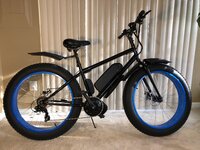@ebikester please note there is a limit on how big to go on the diameter of the crank's chainring. The chainring will need to rotate on its fixed axis, and its teeth need to clear the rear chain stay while transfering rotational pedal energy through the chain. Check the specs and measure the radius from center of crank to rear chain stay x 2 for maximum clearance, and then walk it back a bit for grass/weed debris. The longer the crank arms, the more pedal leverage, and fewer rotations will be necessary to achieve the same number of chain revolutions. A bigger crank may also be slightly harder on knees, if that's a concern. 170mm is pretty standard/comfortable norm for adult bikes (a 52t 170mm is what comes OEM from
Lectric), with either tapered diamond or square at crank (lectric is tapered square). The 172.5 and 175mm are more common on performance racing street/triathlon bikes. I upgraded my Qualisports from 50t OEM to a Litepro 170mm 130BCD 53t (diameter approx 24cm/9.25"), and it works fine. The only reason I did that, was `````````````````````````````````````````````````````````````````````````````````````````````````````````````````````````````````````````````````````````````````````````````````````````````````````````````````````````````````````````````````````````````````````that I had stripped pedal and crank threads and was already having to replace both. I had earlier blindly purchased a 58t without having first measured, and that was a mistake I would spare you from making.
